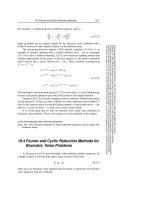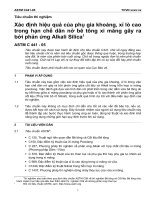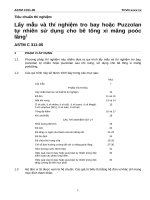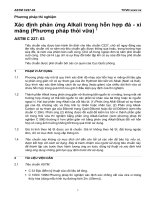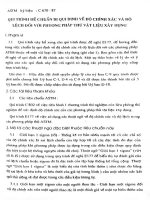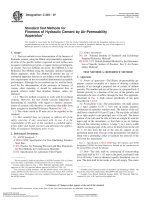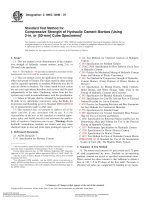Astm c 537 87 (2014)e1
Bạn đang xem bản rút gọn của tài liệu. Xem và tải ngay bản đầy đủ của tài liệu tại đây (87.88 KB, 3 trang )
Designation: C537 − 87 (Reapproved 2014)
´1
Standard Test Method for
Reliability of Glass Coatings on Glassed Steel Reaction
Equipment by High Voltage1
This standard is issued under the fixed designation C537; the number immediately following the designation indicates the year of
original adoption or, in the case of revision, the year of last revision. A number in parentheses indicates the year of last reapproval. A
superscript epsilon (´) indicates an editorial change since the last revision or reapproval.
ε1 NOTE—Introduction added and unit abbreviation corrections made editorially in June 2014.
INTRODUCTION
This test method covers the determination of the reliability of glass coating on metal using high
voltage. It is intended for use by manufacturers of equipment that is designed to withstand highly
corrosive conditions where a failure of the coating in service would cause extreme damage to the
exposed metal. The test method detects not only existing discontinuities in the glass coating, but also
areas where the glass coating may be thin enough to be likely to result in premature failure in service.
2.1.1 glassed steel, glass-lined steel, or glass-coated steel—
designations generally applied to a class of porcelain enamels
that have high resistance to chemical attack at elevated
temperatures and pressures.
1. Scope
1.1 This test method covers the determination of the reliability of glass coating on metal and is intended for use by
manufacturers of equipment that is designed to withstand
highly corrosive conditions where a failure of the coating in
service would cause extreme damage to the exposed metal. Its
use outside the manufacturer’s plant is discouraged because
improper or indiscriminate testing can cause punctures that are
difficult to repair without returning the equipment to the
manufacturer’s plant. This test method detects not only existing discontinuities in the glass coating, but also areas where the
glass may be thin enough to be likely to result in premature
failure in service.
3. Summary of Test Method
3.1 This test method consists essentially of grounding the
metal structure of the equipment to the ground side of a
direct-current high-voltage generator and sweeping the glass
surface with a high-potential probe on the end of an insulated
handle and cable. Wherever a discontinuity exists or the
coating is thin enough (by reason of a concealed bubble or
conducting inclusion, etc.) so that the dielectric strength of the
remaining glass is less than some preset desired amount, the
dielectric strength of air-plus-remaining-glass breaks down and
a discharge occurs. Built-in current-limiting devices ensure
electrical safety to the operator. A variable voltage control
allows selection of a voltage which assures a predetermined
minimum thickness of glass.
1.2 The values stated in SI units are to be regarded as
standard. No other units of measurement are included in this
standard.
1.3 This standard does not purport to address all of the
safety concerns, if any, associated with its use. It is the
responsibility of the user of this standard to establish appropriate safety and health practices and determine the applicability of regulatory limitations prior to use. For specific
precautionary statements, see Section 7.
4. Significance and Use
4.1 The widespread use of glassed-steel equipment in highly
corrosive chemical processes has made it necessary to detect
weak spots in the coating and repair them before catastrophic
failure occurs in service. This test is intended to detect
discontinuities and thin areas in a glass coating on metal to
ensure that the coating is defect free and has sufficient
thickness to withstand the prescribed service conditions. A test
voltage may be selected at any desired value up to 20k V, thus
making the test applicable to a wide range of thickness
requirements. When, because of bubbles or defects, the thickness of glass at any spot is less than enough to withstand the
applied voltage, a puncture results with an accompanying
2. Terminology
2.1 Definitions:
1
This test method is under the jurisdiction of ASTM Committee B08 on Metallic
and Inorganic Coatings and is the direct responsibility of Subcommittee B08.12 on
Materials for Porcelain Enamel and Ceramic-Metal Systems.
Current edition approved May 1, 2014. Published June 2014. Originally
approved in 1964. Last previous edition approved in 2009 as C537 – 87 (2009).
DOI: 10.1520/C0537-87R14.
Copyright © ASTM International, 100 Barr Harbor Drive, PO Box C700, West Conshohocken, PA 19428-2959. United States
1
C537 − 87 (2014)
´1
FIG. 1 Circuit Diagram, 20k V dc Tester
7. Safety Precautions
indication of a defect. Remedial action is then required to
repair the defect before the equipment can be used for
corrosive service. (When such defects are found before the
equipment leaves the manufacturer’s plant another application
of glass can usually be applied and fired to become an integral
part of the coating.)
7.1 The instrument and equipment being tested should be
well grounded both to a good ground and to each other. All
grounding contacts should be clean bare metal and not rusted
or painted metal.
7.2 Handle the insulated probe handle so that the hand
contacts the ground ring to prevent build-up of a static charge
which causes an unpleasant (although not dangerous) sensation
on discharge.
5. Interferences
5.1 Since the test method is electrical, it is necessary to have
a good ground connection between the instrument and the
metal substrate of the equipment being tested. It is also
necessary that the surface of the glass be reasonably clean and
dry. A wet surface will conduct enough of the high voltage to
any exposed metal, including the edges of the glass coating, so
that an indication of a “contact” may be obtained over a large
area instead of at localized spots that can be marked and
identified for repair.
7.3 Keep the probe electrode at least 305 mm (12 in.) away
from conducting surfaces or personnel. Remember that conducting surfaces may lead to personnel at some distance from
the probe. Discharge the probe tip by grounding it after turning
off the instrument and before changing probe tips. Although the
current is low enough to be electrically safe, the involuntary
reaction from a surprise discharge might cause injury.
7.4 Unless the surface to be tested is clean and dry, there
may be sufficient conduction along the surface to cause a
capacitance discharge even if there is no direct path to ground.
Such a capacitance discharge is recognizable from a true
failure because the discharge spark is not confined to certain
spots but is a general discharge to a large area of the moist glass
surface. Continuous application of the probe to such areas
serves only to build up a capacitance charge on the surface of
the vessel eventually resulting in a discharge through the
operator to his discomfort.
6. Apparatus2
6.1 The tester is composed of a source of high-voltage direct
current with a suitable device to limit the current. A constantvoltage transformer is used to supply a more uniform voltage
source than the usual 115 V, 60 Hz line to which it is
connected. The power supply unit consists of a suitable step-up
transformer along with a voltage-control device, a currentlimiting rheostat, a rectifier, and appropriate safety and remote
control relays, meters, as well as an insulated cable and probe
(see Fig. 1 for schematic wiring diagram). The current output
is limited to 2.5 mA. The output voltage is variable up to 20k
V, and the level is indicated by a voltmeter. The handle is
insulated and grounded and is designed to use either a wire
brush-type or a point probe. The brush probe is used for
sweeping larger surfaces of glass coating while the point probe
is better adapted to interior corners and the more restricted
areas.
7.5 A dc tester should never be used in a chemical plant for
discontinuity testing because of the possibility that a capacitive
charge will be developed in the dielectric coating, resulting in
an explosion hazard.
8. Procedure
8.1 The following procedure is applicable to commercially
available test equipment:
8.1.1 Install ground connections to the instrument and to the
equipment to be tested. Provide a separate ground connection
between the instrument and the equipment.
2
When requesting information, specific reference should be made to the ASTM
designation.
2
C537 − 87 (2014)
´1
relay will trip and the dc current will cut off. When this
happens it is necessary to engage first the overload relay and
then the “DC On” switch before the tester is again operative.
8.1.6 Mark the point of failure with suitable chalk (or
crayon) for subsequent repair.
8.1.2 Set the voltage-control knob near the minimum
setting, connect the instrument to the voltage stabilizer, and
connect the latter to the appropriate power line. Turn the power
on and allow the test equipment to warm up for 2 to 3 min to
ensure stabilization of the voltage.
8.1.3 Engage the overload relay and then the “DC On”
switch to apply voltage to the probe.
8.1.4 Hold the probe by the handle with a firm grip on the
ground ring and with the electrode well away from all objects
and personnel, and slowly raise the voltage until the voltmeter
indicates the desired value. Maintain hand contact with the
ground ring of the handle all through the test to avoid a buildup
of static electricity in the operator that might result in an
uncomfortable and annoying (although not dangerous) spark
discharge. Pass the test probe across the coating surface at a
speed not to exceed 40 cm/s.
9. Report
9.1 The report shall include the following:
9.1.1 Title of test, ASTM designation and issue,
9.1.2 Date of test,
9.1.3 Description or identification of equipment being
tested,
9.1.4 Voltage used in the test, and
9.1.5 Number and location of failures.
10. Precision and Bias
10.1 No justifiable statements can be made regarding the
precision and bias of this test method due to the fact that this
method is designed for application to full-sized production
vessels and reactors with the result that variables due to design,
metal composition, fabrication, and metal processing, as well
as porcelain enameling, are introduced into the results.
NOTE 1—The instrument is set to discharge across an internal gap at
slightly over 20k V. If the voltage is set high enough to cause such a
discharge, ionization of the air usually causes the arc to persist until the
voltage is reduced to approximately 5k V. Shortly after the arc has
extinguished, the voltage can be reset to the desired value.
8.1.5 When a point of failure in the coating is approached,
a spark will jump to the point of failure with a visible and
audible discharge or arc. As the path of the arc is shortened, by
bringing the electrode close to the point of failure, the current
in the arc builds up. At a 2.5 mA current in the arc, the overload
11. Keywords
11.1 glass coated steel equipment; glass coating; high voltage test; porcelain enamel; reliability of coatings
ASTM International takes no position respecting the validity of any patent rights asserted in connection with any item mentioned
in this standard. Users of this standard are expressly advised that determination of the validity of any such patent rights, and the risk
of infringement of such rights, are entirely their own responsibility.
This standard is subject to revision at any time by the responsible technical committee and must be reviewed every five years and
if not revised, either reapproved or withdrawn. Your comments are invited either for revision of this standard or for additional standards
and should be addressed to ASTM International Headquarters. Your comments will receive careful consideration at a meeting of the
responsible technical committee, which you may attend. If you feel that your comments have not received a fair hearing you should
make your views known to the ASTM Committee on Standards, at the address shown below.
This standard is copyrighted by ASTM International, 100 Barr Harbor Drive, PO Box C700, West Conshohocken, PA 19428-2959,
United States. Individual reprints (single or multiple copies) of this standard may be obtained by contacting ASTM at the above
address or at 610-832-9585 (phone), 610-832-9555 (fax), or (e-mail); or through the ASTM website
(www.astm.org). Permission rights to photocopy the standard may also be secured from the ASTM website (www.astm.org/
COPYRIGHT/).
3

